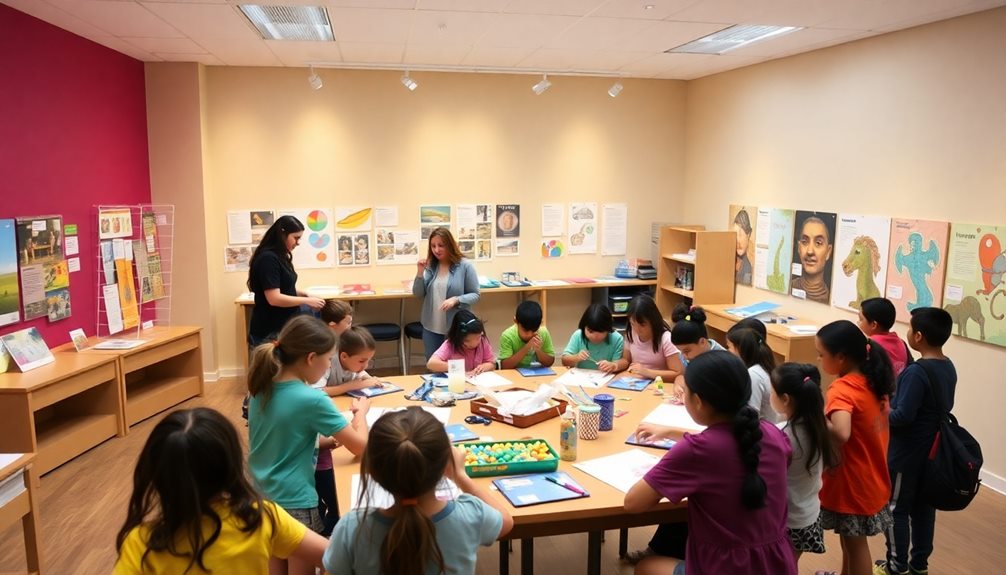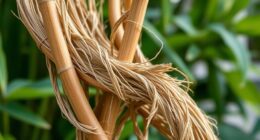Museum labels are your essential tools for charting the intricate world of art and history. They provide vital information about each piece, including the artist's name, creation date, and materials used. These labels aim to demystify complex themes and encourage accessibility for all visitors. You'll find that understanding the context behind an artwork enhances your appreciation and connection to it. By highlighting community contributions, labels can shift your perspective and foster engagement. If you're curious about how labels might evolve to meet changing visitor needs, there's more to explore on this fascinating topic.
Key Takeaways
- Museum labels enhance navigation and comprehension, making art more accessible and relatable to diverse visitors.
- Key components of labels include the artist's name, artwork title, date of creation, materials used, and accession number.
- Historical context and date of creation provide insight into the cultural and political significance of artworks.
- Community contribution labels foster trust and enhance engagement by incorporating local narratives and diverse perspectives.
- Effective labels encourage personal reflection, critical thinking, and a deeper connection between visitors and the artwork.
Purpose of Museum Labels

Museum labels serve as essential guides for you, enhancing your experience as you navigate through the art on display. These labels provide vital information about the works of art, helping you grasp their significance and context. By breaking down complex themes and ideas, museum labels demystify the museum experience, making art more approachable and engaging for everyone.
Moreover, museum labels promote inclusivity by ensuring that all visitors, regardless of their background or prior knowledge, can connect with the art. They answer unspoken questions you might have, enriching your understanding and encouraging you to explore deeper. As you engage with these labels, you'll find they often link to community programs and tours, fostering a richer connection between you and the artworks.
With effective museum labels, art becomes a shared experience, inviting conversations and reflections. You'll appreciate the thought and creativity behind each piece, and you might even discover new perspectives.
Ultimately, these labels are designed to enhance accessibility, making your visit not only enjoyable but also insightful. So, the next time you visit a museum, take a moment to read the labels; they're your guide to a more meaningful art experience.
Key Label Components

As you explore the vibrant world of art, the labels you encounter provide key details that enhance your understanding of each piece. These labels typically include essential components that help you connect with the artwork on a deeper level.
Here's a breakdown of the key label components:
| Component | Description | Example |
|---|---|---|
| Artist's Name | The creator's name, often accompanied by nationality and life dates | Vincent van Gogh, Dutch (1853-1890) |
| Descriptive Title | The artwork's title, prominently displayed in bold | Starry Night |
| Date of Creation | Indicates when the piece was made, sometimes using "circa" for approximate dates | 1889 |
| Materials Used | Lists the materials in descending order of prominence | Oil on canvas |
| Accession Number | A unique identifier for tracking ownership and acquisition | 2023.45.67 |
Understanding these elements not only enriches your experience but also deepens your appreciation for the context and history behind each artwork. So next time you're in a museum, take a moment to read the labels—they're your friend in this artistic journey!
Artist and Maker Insights

Understanding the significance of an artist's background can profoundly shape your appreciation for their work. When you look at a museum label, the artist's name is often prominently displayed, giving you a direct connection to the creator.
Alongside this, you'll typically find life dates, which provide important context about when the artist was active. Knowing these dates helps you grasp the era's cultural influences that may have shaped their art.
Additionally, the artist's nationality can reveal even more about their perspective and techniques, enriching your understanding of the artwork.
In cases where the artist is unknown, labels will note this, reflecting the recognition of unknowns in the art world. Museum curators often play a crucial role here, sometimes providing descriptive titles based on the style or technique of the work.
This curatorial effort emphasizes the importance of acknowledging contributions to art, even when the creator's identity remains a mystery.
Historical Context and Dates

While exploring an artwork, you'll often find that the date of creation plays an essential role in grasping its historical significance. Museum labels typically provide this information, which can range from specific years to general time frames. Understanding when an artwork was created helps you appreciate its relevance within the broader art historical narrative.
Many labels use the term "circa" to indicate approximate dates, especially for older pieces where exact years might be elusive. This nuance is critical; it gives you a sense of the era and the cultural, social, and political environment surrounding the artwork's creation.
Without this historical context, you might miss out on the deeper meanings behind the piece. Additionally, keep in mind that changes in attribution or new discoveries can lead to updates in the artwork's date on museum labels. This reflects ongoing research in art history and reminds you that the field is always evolving.
Material and Ownership Information

Museum labels often detail the material composition of artworks, allowing you to appreciate not just the visual aspects but also the physical elements that contribute to the piece. You'll find substances like acrylic, oil paint, or wood listed in descending order of prominence, which helps you understand the artist's choices and techniques.
In addition to material composition, labels provide vital ownership information through the credit line. This section clarifies who owns the artwork, whether it's a museum, an individual, or another organization. It often specifies the acquisition method, indicating if the piece was donated, purchased, or is on loan.
Every artwork is assigned an accession number, a unique identifier that aids museums in tracking and managing their collections. This tracking is essential for preserving the artwork and determining its accessibility for future exhibitions.
Understanding this ownership information not only informs you about the piece's history but also highlights the responsibilities associated with its care and presentation. By paying attention to these details on museum labels, you gain a deeper insight into the artwork's significance and its journey through time.
Enhancing Visitor Engagement

Engaging with art can transform your museum experience, and thoughtfully crafted labels play an essential role in that engagement. Effective museum labels do more than just describe a work of art; they provoke personal reflection and inquiry by weaving compelling stories that connect you to the artwork's context and significance.
When you read a label that highlights local narratives, you might find your perception shifting, as research shows this happens for one-third of visitors. By incorporating elements of continuous learning and skill development, labels encourage visitors to deepen their understanding and appreciation of the artwork.
Take, for instance, a 2019 label that won an Excellence in Exhibition Label Writing Competition. It exemplifies how well-crafted labels can enhance visitor engagement. Exit surveys reveal that 80% of visitors read community contribution labels, underscoring their importance in enriching your museum experience.
Future Directions for Museum Labels

There's a growing recognition that museum labels can do more than just inform; they can challenge and inspire. As a visitor, you'll appreciate how future labels aim to reveal and reframe historical issues, encouraging deeper engagement. Museum professionals are focusing on incorporating community perspectives, enhancing authenticity, and ensuring relevance. For instance, a 2019 award-winning label demonstrated the power of these narratives.
Here's a glimpse of how future labels might evolve:
| Current Focus | Future Direction |
|---|---|
| Informative text | Engaging narratives |
| Static information | Dynamic community input |
| General audience | Tailored experiences |
| Limited visitor feedback | Continuous community collaboration |
With exit surveys showing that 80% of visitors read community contribution labels and one-third reporting a shift in perception, it's clear that these labels are more than just a line of text. They're becoming a crucial part of the collection, fostering trust and collaboration between museums and their communities. By prioritizing clarity and diverse perspectives, museums can create labels that resonate, inspiring you to think critically about the world around you.
Frequently Asked Questions
What Information Is on Museum Labels?
Museum labels include the artist's name, nationality, and life dates. They list the artwork's title, creation date, materials, ownership details, dimensions, and often provide descriptions to enhance your understanding and engagement with the piece.
What Is the Structure of a Museum Label?
You might think museum labels are just dry facts, but they're structured for clarity. Typically, you'll see the artist's name, artwork title in bold, creation date, materials, and ownership details, all designed to engage you.
What Makes a Good Museum Label?
A good museum label grabs your attention, uses clear language, and answers your questions. It connects the artwork to history and evokes personal reflections, making you curious to explore more about what you're seeing.
What Are the Different Types of Exhibition Labels?
You'll find various exhibition labels, including object labels detailing artworks, interpretive labels providing context, didactic labels teaching techniques, community contribution labels showcasing local voices, wall texts summarizing themes, and interactive labels encouraging engagement.
Conclusion
In understanding museum labels, you reveal the stories behind the art. As the saying goes, "A picture is worth a thousand words," but a well-crafted label adds depth and context. By appreciating the key components, insights, and historical backgrounds, you enrich your experience. As museums evolve, so will their labels, making your visits even more engaging. So next time you're in a gallery, take a moment to read the labels—they're your guide to a deeper connection.









